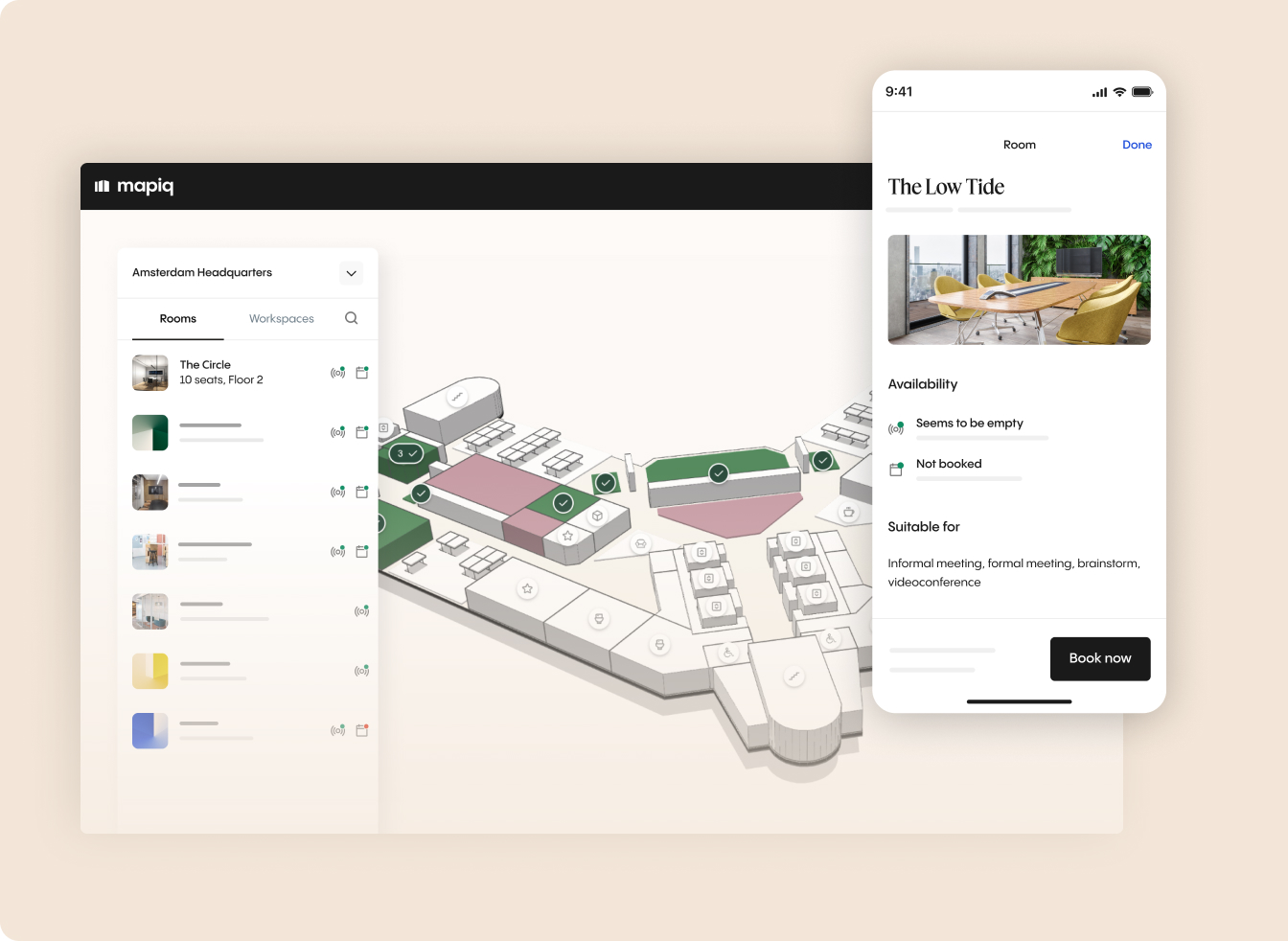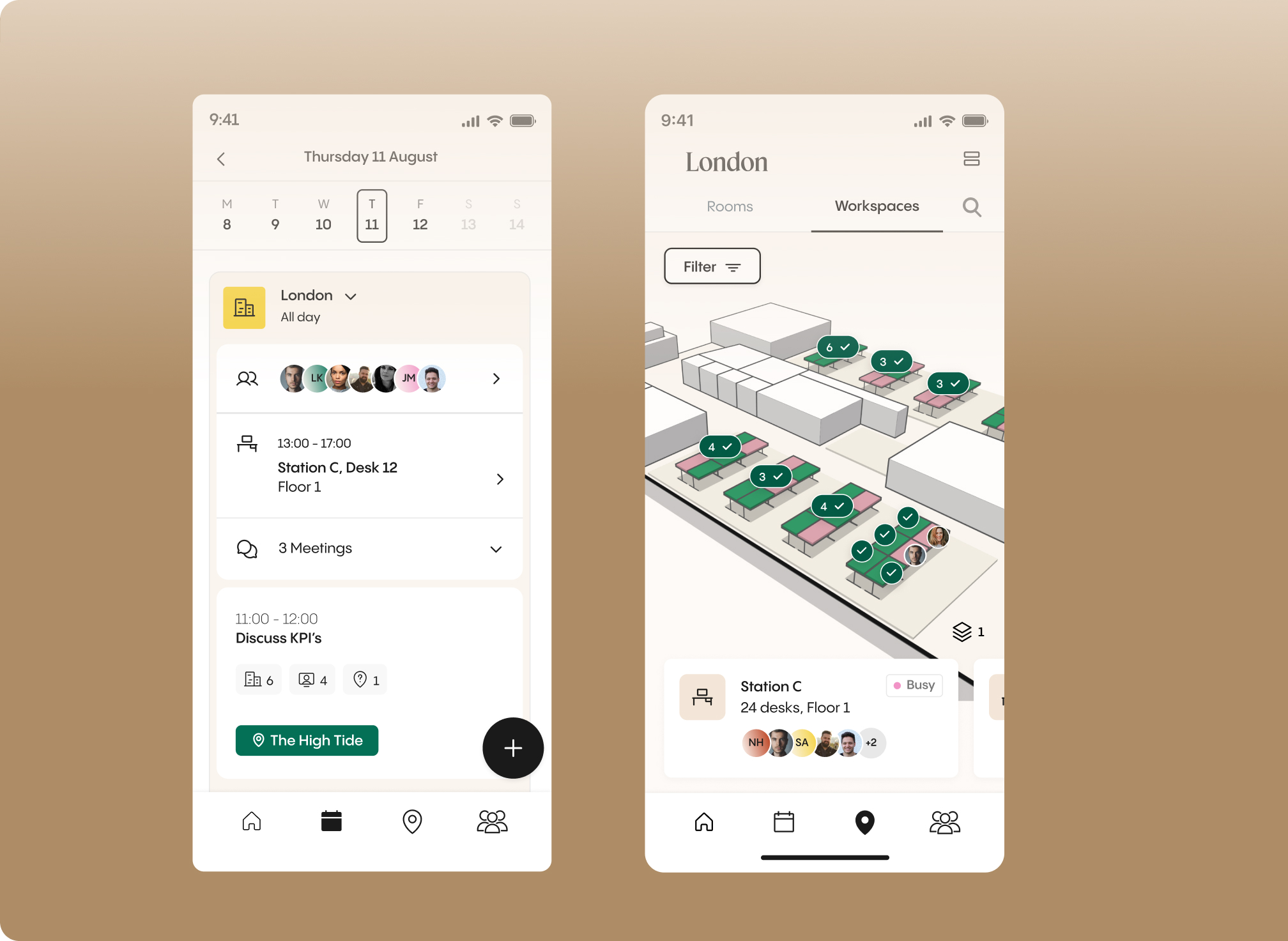Resource Booking Made Simple: The Complete Guide to Workplace Resource Management
Hybrid work promised flexibility, but it delivered a new challenge: how do you manage office resources when no two companies follow the same rules? Some mandate three days in-office, others let teams decide. Some need desks clustered by department, others prioritize individual choice. And when your booking system struggles to accommodate your unique workplace policy, the entire strategy is at risk.

Poor resource booking directly impacts desk usage rates, capacity management across floors and buildings, and how effectively teams can actually collaborate when they do come in. Wasted space translates to wasted real estate spending, sometimes millions annually. Group bookings that should take seconds become coordination nightmares. And when employees can't reliably book what they need, adoption suffers and frustration ensues.
The problem isn't booking systems themselves. It's that most tools ship with rigid feature sets that force you to adapt your workplace policies to their limitations, not the other way around. You need a system that actually handles your unique challenges, whether that's timeslot flexibility, team clustering, reserving services or catering, or all of the above, without requiring multiple tools or complicated workarounds.
This guide breaks down the ten most impactful ways resource booking solves real workplace challenges. Each addresses a specific pain point that affects how employees experience the office and how organizations optimize their real estate investment.
10 Ways Resource Booking Helps
Resource booking is the umbrella term for reserving any workplace resource — desks, meeting rooms, parking spots, areas, and other amenities. It's become essential for managing hybrid workplaces effectively, touching everything from daily employee experience to long-term space strategy.
When done right, resource booking solves real problems that impact how people work and how organizations use their real estate. Here's where it helps:
1. Find the right desk instantly
Employees who have to hunt for available desks waste time and start their day at the office feeling frustrated. Desk booking with smart filters (location, equipment, team proximity) lets them reserve exactly what they need before arrival. For instance, employee filters for desks near their team with monitors Tuesday evening, books one, and shows up Wednesday knowing exactly where to go.
2. Help teams sit together without the hassle
When an eight-person engineering team decides on a collaborative office day, coordinating desk locations becomes a text chain nightmare that leaves the team scattered across floors. Group booking capabilities let one person reserve adjacent desks or entire areas in seconds, ensuring teams sit together when collaboration matters. You can select "group booking" for eight people in a certain neighbourhood on Thursday, the system automatically reserves a cluster of desks and sends confirmations, and everyone knows exactly where to sit.
3. Book and find the right meeting room, not just any room
Small teams often book large meeting rooms because they don't know what's actually available, while bigger teams can't find space because small meetings hog the capacity. Meeting room booking with real-time availability, smart filters and calendar integration ensures rooms match actual meeting needs. When you create a 30-minute meeting in your calendar, you can search for and book an available room that matches your needs, ensuring larger rooms remain available for teams that actually need them.

4. Guarantee a parking spot for everyone
Without parking reservations, employees may arrive at the office to find limited availability, requiring extra time to locate a spot and creating uncertainty about parking access. Parking reservations with one-click booking and automatic gate access eliminate uncertainty, letting employees know before they leave home whether parking is available. You check Wednesday's availability Tuesday night, reserve a spot near the entrance with your license plate, and Wednesday morning the gate opens automatically when you arrive.
5. Turn utilization guesswork into data-driven decisions
Utilization reports showing 25% average occupancy don't reveal which floors, areas, or days are underused, while real estate costs pile up and half the office sits empty. Check-in data combined with booking and sensor data layers data, revealing exactly which spaces are underused, which days are busy, and where to optimize through analytics dashboards that turn gut feelings into informed decisions. Reports showing Floor 3 averages 18% desk utilization while Floor 5 hits 65% enable consolidating teams onto higher-performing floors, converting underused space to flexible meeting areas, and preparing data to justify closing floors, potentially saving thousands annually.
6. Stop ghost reservations from blocking availability
Teams walk floor-to-floor searching for an open meeting room, but every room shows "booked" on the display. When they peek inside, three rooms are completely empty—ghost reservations blocking real meetings. Automated check-in requirements with sensor-based no-show detection free up unused rooms. If no one enters within 10 minutes of the booking start time, sensors detect the empty room and automatically release it back to availability. Someone books a room for 2 PM, but their meeting gets canceled and they forget to cancel the booking. Sensors detect no one entered by 2:10 PM and auto-release it, and teams searching for last-minute space see it appear as available and book it immediately.
7. Know where your teammates are before you commute
When a distributed team decides Tuesday is their office day but nobody coordinated locations, team members end up scattered across different floors while others work from home assuming nobody else was coming in. Connections features show where teammates are booking, enable schedule sharing, and allow invitations to office days so teams can cluster in the same area.

8. Avoid chaos on busy days with capacity management
Mid-week office days hit peak capacity while Mondays and Fridays stay quiet, leading to overcrowded buildings, unavailable hotdesks, and fully booked meeting rooms. Capacity management with real-time tracking shows exactly when and where buildings approach limits, letting workplace managers allocate space strategically, communicate capacity trends, or open overflow areas before problems escalate.
9. Book services and amenities beyond desks and rooms
Employees need to reserve lockers for secure storage, order catering, or escalate facility tickets for IT support, but without a centralized system they make phone calls, send emails, or rely on manual coordination. Amenities and services booking extends beyond desks and rooms to lockers, catering, ticket escalation, and other extras, letting employees reserve what they need with the same ease as booking a desk.
10. Adapt booking rules to your unique policies
Companies often require senior leadership to have guaranteed desk access, limit hot-desking to 3 days in advance for most employees, and need specific departments to book only in their designated areas, but rigid booking systems can't handle these rules, forcing manual workarounds and constant policy violations. Flexible booking rules and restrictions per building, floor, area, and user role ensure your system adapts to your workplace policies, letting admins set who can book where, when, and for how long.
Getting Started with Resource Booking
Getting employees to actually use a new booking system comes down to making adoption easy and rollout strategic. Start where the pain is most acute. If meeting rooms are the daily crisis, launch with room booking first. If parking creates morning chaos, tackle that. Rolling out everything at once can overwhelm people, but solving one visible problem builds trust and momentum for the rest.
Start with your highest-pain areas. If meeting room chaos is killing productivity, deploy room booking first. If parking is the daily crisis, tackle that. You don't need to solve everything on day one. Mapiq can launch core features in days, not months, with customized onboarding including managing your floor plans and integration setup without requiring an army of IT resources.
Change management matters more than the technology. Employees won't adopt a system they don't understand or trust. Communicate why you're implementing resource booking, tie it to real pain points they already feel. Offer drop-in training sessions, video walkthroughs, and champions in each department who can answer questions and model good behavior. Mapiq provides every customer, regardless of plan, with a dedicated customer success manager who delivers best practices and ongoing support.
The support infrastructure should outlast launch week. Ongoing training resources, responsive support teams, and regular feature updates ensure the system grows with your needs. Resource booking isn't a one-time deployment; it's a foundation for how your workplace evolves.
Ready to eliminate booking friction and optimize your workplace?
Explore how Mapiq's resource booking platform adapts to your unique policies and scales with your needs.




